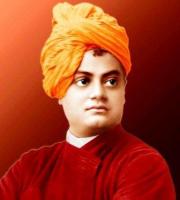Creation and Criticism
ISSN: 2455-9687
(A Quarterly International Peer-reviewed Refereed e-Journal
Devoted to English Language and Literature)
Vol. 01, Issue 03 : Oct 2016

Poetic Techniques of Indian Saint Poets in English: Fusion of Philosophical and Aesthetic Appeal
Richa Sharma
Abstract:
Indian Saint Poets in English have employed the poetic techniques, which have created a fusion of philosophical and aesthetic touches. Swami Vivekananda, Swami Ram Tirtha and Sri Paramahansa Yogananda have done the miracles and made the reader visualise the philosophical concept of God, Self and Nature with the help of picturesque images, lively figures and well packed phraseology. Swami Vivekananda weaves the fabric of his poems with figures, poetic beauty, and forceful words. Swami Ram Tirtha’s poetry is the poetry of soul. His poems have aesthetic feelings and give the reader such delight and peace as take him to the other world. Sri Paramahansa’s phraseology is suggestive and picturesque. Like Swami Ram Tirtha, Swami Paramahansa Yogananda has also used the scientific and technical words to give the real touch to his poems. Philosophical strains in the saint poetry are fused with lyrical touches which create an aesthetic appeal.
Keywords: saint poetry, mysticism, figures, intuition, imagery, aesthetic appeal, self-realization
The saint poets—Swami Vivekananda, Swami Ram Tirtha and Swami Paramahansa Yogananda write spiritual and mystical poems. The poems have come from their pens only when they feel intoxicated with peace and bliss. Their poetry is an outcome of peace and joy out of the communion with God, Nature and Man. All of them are intensely lyrical. A beautiful fusion of lyrical and philosophical strains appeals to the heart and offers the aesthetic sense. Picturesque description, lively images and speaking figures mark their poetry.
Swami Vivekananda loves Nature and so employs the techniques to make her picturesque. Nature seems to be alive in his description. The objects of Nature seem to speak. The magic of the pen has made Nature picturesque. Here is an excerpt from the poem ‘To The Awakened India’ which makes the early morning appear on the screen of the mind again and again. The poet in Vivekananda has employed imagery and figures like ‘Personification’ to make it more appealing and picturesque.
Before thy magic touch, the world
Awakes. The birds in chorus sing.
The flowers raise their star-like crowns,
Dew set, and wave thee welcome fair,
The lakes are opening wide in love.
Their hundred thousand lotus eyes
To welcome thee, with all their depth
All hail to thee, thou Lord of Light!
A welcome now to thee, today,
O Sun! Today thou sheddest Liberty (In Search of God 23-24)
In his poems, he employs the genres like ballad, lyric and dramatic monologue. He uses refrain and also blank verse in some of his poems. His poems are replete with lyricism. Music, intensity of feeling and spontaneity mark his lyrics. Artificiality is nowhere. Poems are the outcome of his Self-realization. Music flows from his heart naturally. He has given a proper rhythm to his poems. Due to proper rhythm, the poems move and make progress like the progress in the spiritual experiences.
The poet in Vivekananda employs figures like simile, metaphor and personification to give flow to his emotions, feelings and experiences. Suggestive symbols enrich his poems.
Here are some instances of figures which decorate his poems.
Metaphor:
This world’s a dream
Though true it seem (In Search of God 9)
Oxymoron:
Where life is living death, alas! and death (In Search of God 11)
Personification:
Then sorrow came—and Wealth and Power went
And made him kinship find with all the human race (In Search of God 27)
Alliteration:
Or sea of sorrow swells (In Search of God 32)
A beautiful fusion of Personification and Simile:
Behold, the dark clouds melt away,
That gathered thick at night, and hung
So like a gloomy pall above the earth!
Before they magic touch, the world
Awakes. The bird in chorus sing.
The flowers raise their star-like crowns ,
Dew-set, and wave thee welcome fair (In Search of God 23)
Here are some instances of the symbol of light, used in various ways.
The cloud puts forth its deluge strength
When lightning cleaves its breast (In Search of God 6)
Open the gates of light
O Mother to me Thy tired son(In Search of God 10)
Symbols enrich his poetry. Fetters show enslavement. Gold becomes greed. Images make his description lively and suggestive. Life becomes a cup of Tantalus. The use of Om Tat Sat and Om makes his poems soothing to ears. Their sounds take the reader to the spiritual world. The use of sensory and auditory images directly appeals to the senses of the reader who cannot remain without appreciating when he feels the senses and hears the sound in mantric words.
Here is an instance of the auditory image which makes the reader wonderstruck:
There Shiva dances striking both his cheeks; and they resound, Ba-ba-
bom!
Dimi-dimi-dimi! sounds His tabor; a garland of skull from His neck is
hanging! (In Search of God 39)
Here are some striking lines which reveal his deep love for Indian ancient wisdom and culture.
He conquers all who conquers self. Know this
And never yield, Sannyasin bold! Say—
‘Om Tat Sat, Om!’ (In Search of God 16)
But Fate is strong
This is the law—all things come back to the source
They sprung, their strength to renew. (In Search of God. 22)
Awake, arise, and dream no more! (In Search of God 23)
Indian words like Om Tat Sat Om, Sannyasin, Ba-ba-bom, Dimi-dimi-dimi, Brahman, Devas, Prema, Dharma, Shyama, Krishna, Pralaya, Atman, Brahmin, Maya, Prakriti, Shivoham, Nirvana and the like are found in his poems. These Indian words reveal his love for Indian culture. He has shown a good command over English language. He has woven the fabric of his poems with figures, poetic beauty, and forceful words. His poetic style is dipped in the ink which contains the ingredients like spontaneity, musicality, melody, and above all, simplicity. While praising Vivekananda’s poetry, Sudhir K. Arora writes:
His poetry is the poetry of spiritual intuition that makes him forget the world outside as he is lost in the inner world where he communes with the Divine. As it comes from within, it has mystical touches coloured with a proper fusion of rhythm, melody, music and diction. He has composed his poems almost in moments of bliss and, so, succeeds in developing mystical vision as well as aesthetic sense resulting in making him a mystic artist that selects intuitively concrete imagery, telling figures, revealing symbols and Indian myths. His imagery is touched with the objects of Nature like the sun, the moon, the sky, water, flowers, trees etc., which appear and reappear signifying the presence of the divine spirit. (83)
Rachna Mehrotra writes about the techniques used by Vivekananda in his poetry:
Swami Vivkananda had a perfect command over English language. He was an excellent artist at work handling the language with superb skill. His poems are the outpourings of a heart, the spontaneous outburst of a heart deeply stirred. He employed appropriate styles, harmonious vocabulary and forceful phraseology in his poems. The use of different figures of speech gives a touch of poetic beauty. (86)
Satish Kumar considers Vivekananda’s poetry flawless. He writes:
Vivekananda’s command over English is flawless. His poetic style is characterized by simplicity, gracefulness, picturesqueness, abundant use of highly suggestive symbols and images, spontaneity, harmony, lyrical intensity, musical motion and rapidity of movement. (32)
Swami Ram Tirtha is a poet who has given an outlet to his feelings and Vedantic thoughts through his poems. Initially he is a mathematician. To read a mathematician’s poems gives a different kind of pleasure. His poems are raw and somewhat lacking in form but the content of Indian cultural values makes them appealing and inspiring. His cultural values move the reader. His poems are lyrical in nature. His poems have taken the form of songs—devotional and mystical. These songs give peace of mind and take the reader to the other world. He has enriched his poems through the use of figures. But he never makes them artificial. He avoids too much use of figures.
Here are beautiful instances of figures of speech:
Simile:
Peace like a river flows to me (Poems of Rama 69)
Metaphor:
Oh! brimful is my cup of joy,
Fulfilled completely all desires (Poems of Rama 29)
Oxymoron:
The mindless thought, the eyeless sight
The mouthless talk, the handless grasp so tight. (Poems of Rama. 80)
Onomatopoeia:
With Swoo-oo and Ai-yu!
Oh! bodiless Vayu! (Poems of Rama 193)
Personification:
The flowers smile and nod with glee (Poems of Rama 23)
Sometimes great thoughts flow from the heart so naturally that they become quite striking. Here are some instances of great striking lines:
Not to know Thee is misery
To know Thee is bliss (Poems of Rama 105)
He is I, I He.
No He, She, Me, or Thee.
Om! Om! (Poems of Rama 118)
God is Real, the World unreal
And the Law a living force (Poems of Rama 154)
Wake up, wake up, arise, awake!
Tear off the evil, your slumbers shake! (Poems of Rama 163)
Turn Inward, know the Self supreme,
No more shall maladies be seen.
Ye realise the inner Ram (Poems of Rama 178)
O sacred fellow, just know thyself (Poems of Rama 199)
Swami Ram Tirtha is much influenced by the romantic poets, particularly Wordsworth. He employs pathetic fallacy when he treats the natural objects as the human beings. He uses the terminology of science to give correctness to his feelings. Here are some instances of the use of terminology of Science:
With a wondrous Chemistry, with a strange Electricity (Poems of Rama 123)
O Truth! Radium pure! (Poems of Rama 126)
The use of simple poetic diction makes Swami Ram Tirtha’s poems gripping. Simple phraseology does not create hindrances for the reader. The use of adjectives is also appealing. ‘Silvery moon’, ‘delicious neatness’, ‘the playful ripples’, ‘waving trees’ etc. are some instances of the use of adjectives. His poetry is the poetry of soul. His poems have aesthetic feelings and give the reader such delight and peace as take him to the other world. His poems are lyrical. He has written on God, Nature, Man and made his poems mystical and spiritual. The use of OM again and again in poems produces a soothing effect to the mind. He has woven the fabric of his poems with suggestive symbols and rich images. While praising Swami Ram Tirtha, Rachna Mehrotra writes:
The poet uses natural diction in his poems. His poetic style is simple and sincere as the language of everyday life. It gives a strength and grandeur to his divine inspirations. His language was that of the sweet innocent child, the birds, the flowers, the flowing stream, the waving tree branches that of the sun, the moon and the stars. His was the language of a divinely inspired being. (110)
Sri Paramahansa Yogananda is a poet of devotion, prayers and mysticism. He is much influenced by Rabindranath Tagore’s Gitanjali. His Whispers from Eternity is a collection of prose songs based on the model of Tagore’s Gitanjali. While praising the poetic techniques of the poet in Yogananda, Sudhir K. Arora writes:
The poet in Yogananda has proved his poetic skill in his poems which are filled with devotion, spiritualism and mysticism. He has employed various techniques to communicate his lived experiences in God-realization. He has employed simple and easily communicable English in presenting his spiritual ideals. Words which he has selected flow with the flow of music and reveal his intuition to the maximum. ‘Mystical thoughts in musical diction’ is the proper phrase that applies to him for his poetic spiritual adventure. What he says, he says with full faith and honesty. Sincerity of emotions remains unquestionable. Even an obscure idea opens its layer at his poetic touch. Figures, symbols and images which are mostly taken from the world of Nature help in highlighting his vision of God-realization and the unity in the universe. His vocabulary is so extensive that he has employed words with sense and music from every field of knowledge—be it Nature or technology or any other. (118)
The poet is accurate in his description. He gives the accurate expression to what he has experienced during his sadhna. He has used mystical thoughts in simple words. A reader flows with the flow of feelings, expressed in the short pieces. He uses figures naturally. Here are a few instances of his use of figures:
Metaphor:
The door of memories swings open. (Whispers 52)
Simile:
Teach me to be like the ripe orange which, though crushed and bitten,
fails to impart its innate sweetness. (Whispers 53)
Oxymoron:
Father, teach me to be calmly active and actively calm. (Whispers 59)
Alliteration:
our delicate adjustments of the dial of divine discernment (Whispers 87)
Some lines are so deep in thoughts and feelings that they have become the rich treasure house of Indian culture. These lines take the reader to the other world where he endeavours to find out the real meaning of life. Here are some examples of such striking and meaningful lines:
Inspire us with spiritual understanding, that we overcome fear and hate.
(Whispers 78)
Forget me not, though I forget Thee. Remember me, though I remember
Thee not. (Whispers 82)
I am lost in the wastelands of wrong beliefs; I cannot find my way. O
Compassionate Lord, lead me to Thyself, who art my Home! (Whispers 91)
Craving, struggling, weeping, and smiling for others, at last may I find my
Self in all. (Whispers 100)
His phraseology is suggestive and picturesque. He creates the lively images and fills the words with magical effect. ‘Dagger of conscience’, ‘sharks of passions’, ‘shrine of meditation’ etc., are some phrases which reveal Yogananda’s skill as an accomplished poet. Like Swami Ram Tirtha, Swami Paramahansa Yogananda has also used the scientific and technical words to give the real touch to his poems. The use of scientific terminology can be seen in lines like “O Omnipresent Protector! when clouds of war send rains of gas and fire, be Thou my bomb shelter”, “Reveal me the mystery of Thine incessant dance in protons and electrons”, and “Through the star in opal eye, / See the Christ everywhere, / Sleeping in every atom, / In protons, electrons.” In his poems he has used the mantric words which have turned his poems into songs. His poetry collection Words of Cosmic Chants in Hindi and English is full of such appealing and meaningful songs. These songs have a deep effect on the soul of the reader who feels highly elated and peace within.
Rachna Mehrotra praises Yogananda for simplicity and sincerity. She writes: “Sri Yogananda’s poems are composed in simple and charming language. He has employed words that are saturated with sincerity, conviction faith and intuition” (259). For Satish Kumar he is not obscure despite the fact that he packs the lines with philosophical touches. While praising him, he writes:
Sri Yogananda’s poetry shows his immaculate command over English. He could express deep and profound mystical thoughts, and his spiritual experiences in flawless, fluent, musically flowing and simple language. His language is charged with sincerity, truth of his convictions and experiences. He is never obscure and abstract. (143)
To conclude, the poetic idiom used by the saint poets is fused with philosophical and aesthetic touches. These poets do the miracles and make the reader visualise the philosophical concept of God, Self and Nature with the help of picturesque images, lively figures and well packed phraseology. Hence the saint poetry in English flows through a poetic idiom which is picturesque in description, lively in images and telling in figures. Philosophical strains are fused with lyrical touches which create an aesthetic appeal.
Works Cited:
Arora, Sudhir K. Cultural and Philosophical Reflections in Indian Poetry in English: Journey. New Delhi: Authorspress, 2016. Print.
Kumar, Satish. A Survey of Indian English Poetry. Bareilly: Prakash Book Depot, 2001. Print.
Mehrotra, Rachna. Mysticism in Indian English Poetry. Mumbai: B.M.S. Publication, n. d. Print.
Tirtha, Swami Ram. Poems of Rama. Lucknow: The Rama Tirtha Prastisthan, 1986. Print.
Vivekananda, Swami. In Search of God and Other Poems. Kolkata: Advaita Ashram Mayavati, 1981. Print.
Yogananda, Sri Paramahansa. Whispers from Eternity. Dakshineswar: Yogoda Satsanga Society of India, 1986. Print.
---. Words of Cosmic Chants in Hindi and English. Calcutta: Yogoda Satsanga Society of India, 1987. Print.
---. Songs of the Soul. Los Angeles, California: Self-Realization Fellowship, 1983. Print.
 About the Contributor:
About the Contributor:
Richa Sharma is a research scholar. She is doing her research on “Cultural Values in Indian Saint Poetry in English” from Shri Venkateshwara University, Gajraula. She worked on a major research project, titled “Indian Culture in Indian English Poetry” as a Project Fellow with Dr. Sudhir K. Arora. She lives at F-15, Wave Green Colony, In front of Westend Mall, Moradabad-244001, Uttar Pradesh, India. Email: mani_lnipe@rediffmail.com


